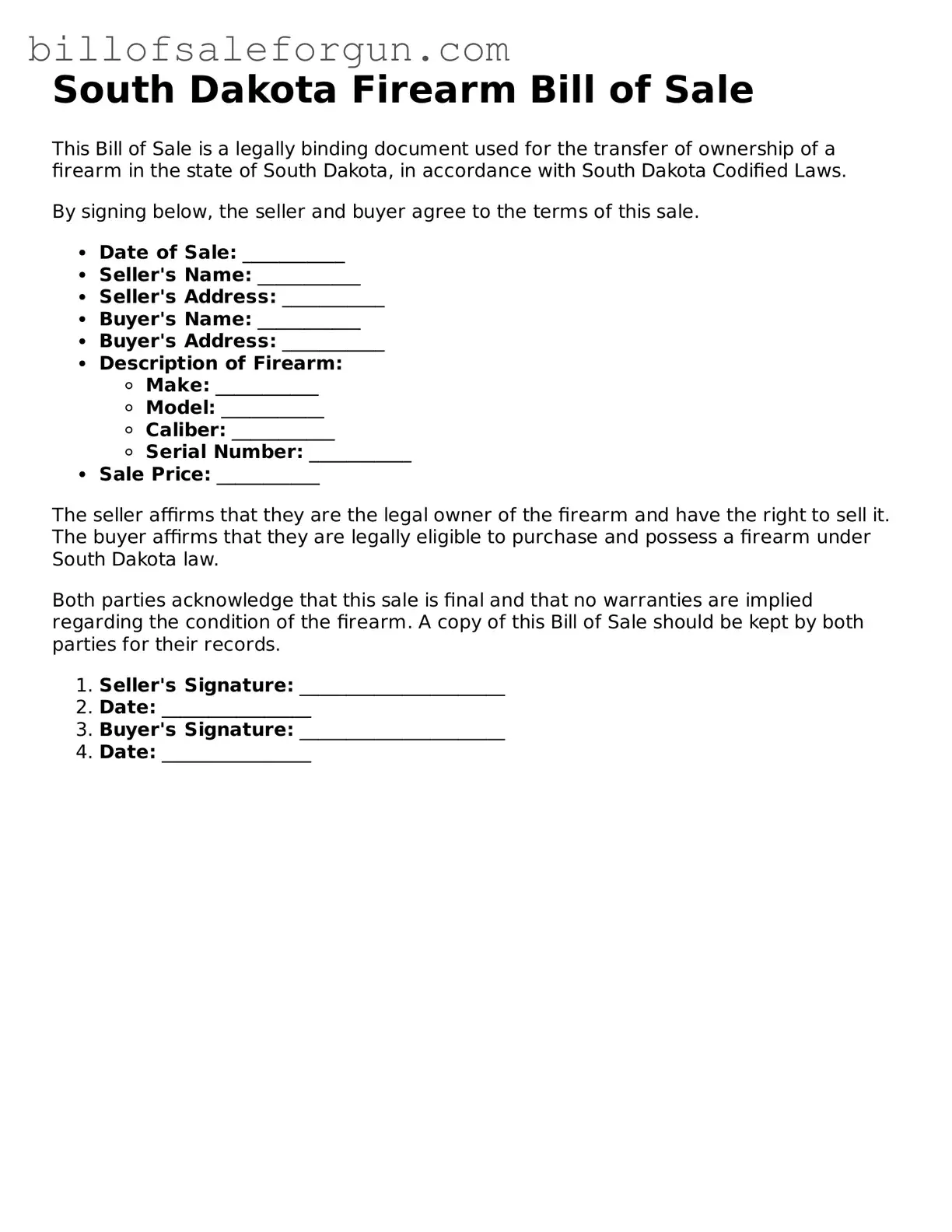Similar forms
The South Dakota Firearm Bill of Sale form shares similarities with a general Bill of Sale document. Both serve as legal instruments that record the transfer of ownership of a tangible item, in this case, a firearm. They typically include essential details such as the names and addresses of the buyer and seller, a description of the item being sold, and the date of the transaction. The general Bill of Sale can apply to various items, including vehicles and personal property, making it a versatile document in personal and commercial transactions.
Another document akin to the South Dakota Firearm Bill of Sale is the Vehicle Bill of Sale. This document is specifically designed for the transfer of ownership of motor vehicles. Like the Firearm Bill of Sale, it captures crucial information such as the vehicle identification number (VIN), make, model, and year of the vehicle, along with buyer and seller details. Both documents provide proof of ownership and can serve as evidence in case of disputes regarding ownership or condition of the item sold.
The Lease Agreement is another document that shares some characteristics with the Firearm Bill of Sale. While it primarily governs the rental of property, it also includes essential details about the parties involved and the item in question. Both documents establish a formal agreement between two parties, outlining the responsibilities and rights of each party. In the case of a Lease Agreement, the duration and terms of the lease are specified, whereas the Firearm Bill of Sale focuses on the transfer of ownership.
A Purchase Agreement is similar to the South Dakota Firearm Bill of Sale in that it outlines the terms of a sale between a buyer and a seller. This document includes details about the item being sold, the purchase price, and any conditions or warranties associated with the sale. Both documents serve to protect the interests of both parties and provide a clear record of the transaction, ensuring that both the buyer and seller understand their obligations.
The Receipt is another document that bears resemblance to the Firearm Bill of Sale. A receipt serves as proof of payment for goods or services rendered. In the context of a firearm sale, a receipt may accompany the Bill of Sale, providing evidence that the buyer has paid for the firearm. Both documents are critical for record-keeping and may be required for future reference or legal purposes.
The Transfer of Ownership form also parallels the South Dakota Firearm Bill of Sale. This document is used in various contexts, such as transferring property or vehicles. It includes the necessary details about the parties involved and the item being transferred. Similar to the Firearm Bill of Sale, this form establishes a legal record of the transfer, ensuring that the new owner is recognized for legal and administrative purposes.
For businesses navigating the complex landscape of tax obligations in Florida, it is essential to familiarize themselves with necessary documentation, such as the download the document in pdf to ensure compliance with local laws and requirements.
The Warranty Deed is another document that shares some attributes with the Firearm Bill of Sale, particularly in its role of transferring ownership. A Warranty Deed is used in real estate transactions and provides a guarantee that the seller holds clear title to the property being sold. While it typically involves real property rather than personal property like firearms, both documents serve to formalize the transfer of ownership and protect the interests of the buyer.
Finally, the Affidavit of Ownership can be compared to the South Dakota Firearm Bill of Sale. This document is often used to assert ownership over an item when formal documentation is lacking. It includes a sworn statement from the owner regarding their possession of the item. Both documents help establish and confirm ownership, although the Affidavit of Ownership may not include the same level of detail about the transaction as the Firearm Bill of Sale.
